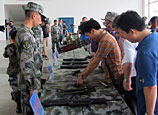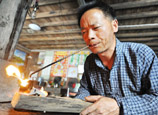
It was usually quiet Friday morning at the Baoshan Cement Co., Ltd. factory in east China's Jiangxi Province.
The factory's production lines were shut down after it was put on a list of companies designated by the Ministry of Industry and Information Technology to be shut down due to overcapacity.
More than 1,400 companies in 19 industries have been asked to reduce their production capacity.
According to the ministry, the closures must be completed by the end of September and production may not be transferred to other regions.
China is the world's biggest producer of steel, aluminum and cement. Overcapacity in a number of sectors has dragged down prices and profit margins for some enterprises amid China's economic slowdown.
Official statistics indicate that only 72.5 percent, 78 percent and 67 percent of capacity is used for the alumina, electrolytic aluminum and steel sectors, respectively, last year, far less than that of other countries.
The iron and steel industry reported losses of 699 million yuan (113 million U.S. dollars) in June, the first monthly deficit to hit the industry this year.
The combined profits of members of the China Iron and Steel Association (CISA) hit 2.27 billion yuan in the first half, with an average profit margin of 0.13 percent, the lowest among all industries, according to CISA.
The double-digit economic growth China embraced in the past decades has largely disappeared alongside a sluggish global economy. China's economic growth slowed to 7.5 percent in the second quarter from 7.7 percent in the first three months.
The government is trying to curb overcapacity as part of efforts to shift the economy away from investment in heavy industry. Instead of initiating another massive stimulus program to lift the economy, authorities are moving cautiously to keep growth steady while implementing related reforms.
President Xi Jinping urged in late July that tackling overcapacity should be prioritized, with more efforts to boost industrial restructuring.
The investment-driven growth that boosted China's economy in years past is not sustainable, said Asian Development Bank economist Zhuang Jian, adding that the government should use this time as an opportunity to reduce overcapacity and transform the economy.
It has been a decade since authorities began to shut down steel, cement and electrolytic aluminum producers who were at overcapacity. The number of industries targeted for reducing capacity has grown from three in 2003 to 19 in 2013.
In north China's Hebei Province, the country's largest steel producer, authorities announced a plan in 2010 to cut the province's steel manufacturing capacity to less than 95 million tonnes by 2015.

















 Man commits suicide, rescued by his wife in NE China
Man commits suicide, rescued by his wife in NE China


![]()
